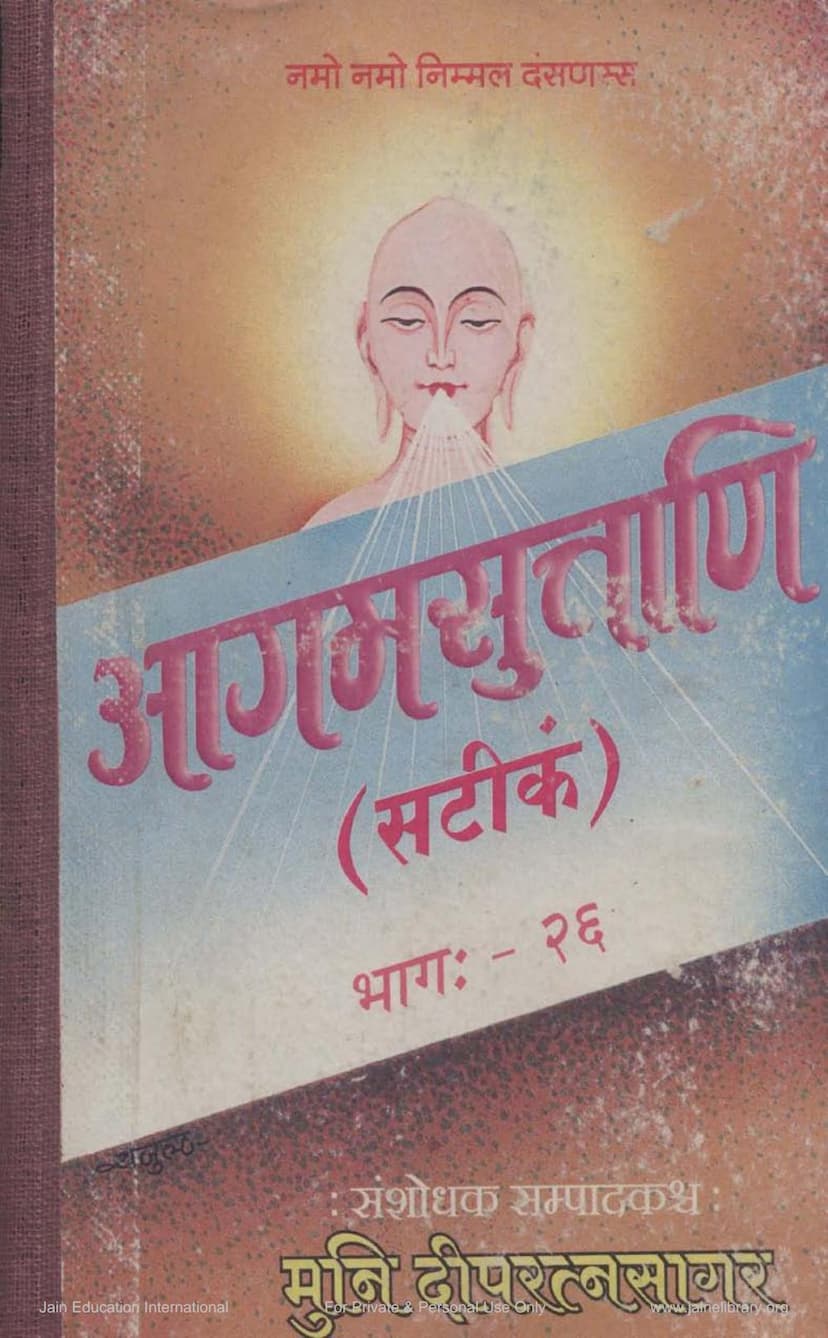Agam Sutra Satik 41B Pindniryukti MoolSutra 2b
Added to library: September 1, 2025

Summary
The provided Jain text, "Agam Sutra Satik 41B Pindniryukti MoolSutra 2b," authored by Dipratnasagar and Deepratnasagar, and published by Agam Shrut Prakashan, is a commentary on the Pindaniryukti, a fundamental text in Jainism. This work, part of a larger series titled "Aagam Suttani (Satik)," specifically delves into the intricacies of the Pindaniryukti, which is itself a commentary on a portion of the Dashavaikalik Sutra, one of the foundational texts of Jain canonical literature (Agamas).
Here's a comprehensive summary based on the provided pages:
Core Subject Matter:
The book is primarily concerned with the Pindaniryukti, which is an explanation and elaboration of the fifth chapter of the fifth study (Adhyayan) within the Dashavaikalik Sutra, known as the Pindaiṣaṇā (related to alms-seeking and sustenance). The Pindaniryukti is attributed to Bhadrabahu Swami, a revered Jain acharya. The commentary (Satik) is by Malayagiri Acharya.
Structure and Content:
-
Pages 1-5: These initial pages set the stage. They include:
- Invocation and salutations to Jain deities and spiritual preceptors.
- Book title, author, publisher, and series information.
- A table of contents (विषयानुक्रमः) outlining the key topics covered in both the Oghaniryukti and the Pindaniryukti. The Pindaniryukti section focuses on eight main topics:
- Udgama (उद्गम): Origin and associated faults.
- Utpadana (उत्पादन): Acquisition and faults related to it.
- Eshaṇā (एषणा): Seeking and faults related to alms-seeking.
- Sanyojana (संयोजना): Combination (of food items, etc.) and faults.
- Pramāṇa (प्रमाण): Measure (of food, etc.) and faults.
- Aṅgāra (अङ्गार): Embers (faults related to fire/heat).
- Dhūmra (धूम्र): Smoke (faults related to smoke).
- Upasanhāra (उपसंहार): Conclusion.
- A list of financial contributors (आर्थिक अनुदात्ता) to the publication, highlighting the importance and community support for this work.
-
Pages 6-22 (and beyond, as indicated by page numbering): These pages begin the detailed exposition of the Pindaniryukti and its commentary.
- Introduction to Niryuktis: The text clarifies that Niryuktis are not independent treatises but are dependent on specific Sutras. They explain and clarify the meanings of terms found in those Sutras, especially for disciples.
- Definition of "Pinda" (पिण्ड): The term "Pinda" is explained as a collection or aggregation of things, often referring to a collection of material substances, but in this context, more specifically to material provisions that support ascetic practices like self-discipline. The focus is on the "Pinda of the body" and its relation to asceticism.
- Classification of Pinda: The text starts by explaining the various categories and classifications of "Pinda," leading into the eight subject areas mentioned in the table of contents.
- Detailed Exploration of Topics: The commentary proceeds to explain each of the eight topics (Udgama, Utpadana, Eshaṇā, etc.) in detail, likely through verses (Gathas) and their explanations. For instance, the explanation of "Pinda" itself, its synonyms, and its classifications (like Nama Pinda, Sthapana Pinda, Dravya Pinda, Bhava Pinda) are discussed.
- Nixepa (निक्षेप): The concept of Nixepa (classification or setting forth) is introduced for the term "Pinda," which can be done in a fourfold or sixfold manner, explaining the nature of the Pinda in terms of name, establishment, substance, place, time, and quality/action.
- Prakarana (प्रकरण): The text emphasizes the importance of the context or subject matter (Prakarana) in understanding the Jain Agamas. The Pindaniryukti is presented as a distinct section within the larger Dashavaikalik Sutra's niyukti.
- Specific Examples and Categories: The text details various aspects related to the Pindaniryukti, such as:
- Types of Pinda based on substance (e.g., Pṛthvīkaya Pinda, Apkaya Pinda, Tejas Kaya Pinda, Vayu Kaya Pinda, Vanaspati Kaya Pinda, Dvīndriya, Trīndriya, Chatura-indriya, Pañcha-indriya).
- The concept of Sachiṭṭa (with life), Achitta (without life), and Miśra (mixed) in relation to these entities.
- The purpose and classification of these substances for monks (e.g., for sustenance, clothing, utensils, and various other activities).
- The elaborate explanation of food-related principles, including acceptable and unacceptable items, preparation methods, and the faults associated with them (Udgama, Utpadana, Eshaṇā, Sanyojana, Pramāṇa, Angara, Dhūmra).
- The detailed discussion of the "Eshaṇā" (alms-seeking) and its various aspects, including the conduct of monks and nuns.
Key Jain Concepts Highlighted:
- Agamas: The foundational scriptures of Jainism.
- Niryukti: A type of commentary that explains and clarifies the meaning of terms and concepts within an Agama Sutra.
- Satik: A commentary on a Niryukti.
- Dashavaikalik Sutra: One of the foundational Jain Agamas, dealing with conduct, vows, and daily life of ascetics.
- Udgama, Utpadana, Eshaṇā: These are crucial concepts related to the ethics of alms-seeking and sustenance for Jain monks and nuns, focusing on the purity of the origin, acquisition, and consumption of food.
- Sixfold Kaya (Lifes): The Jain concept of six types of living beings (earth-bodied, water-bodied, fire-bodied, air-bodied, plant-bodied, and mobile beings) is central to understanding the ethical implications of actions, especially concerning food and its acquisition.
- Sachiṭṭa, Achitta, Miśra: Classifications of substances based on the presence of life or its potential.
- Karma and Moksha: The underlying philosophy is to minimize harm (Himsa) and purify oneself to attain liberation (Moksha).
In essence, the Pindaniryukti, as explained in this commentary, provides a highly detailed and rigorous framework for Jain ascetics to practice non-violence (Ahimsa) and purity in their daily lives, particularly in the critical area of sustenance, ensuring that their practices align with the highest ethical principles of Jainism. The commentary helps to unravel the philosophical and practical nuances of these ancient injunctions.